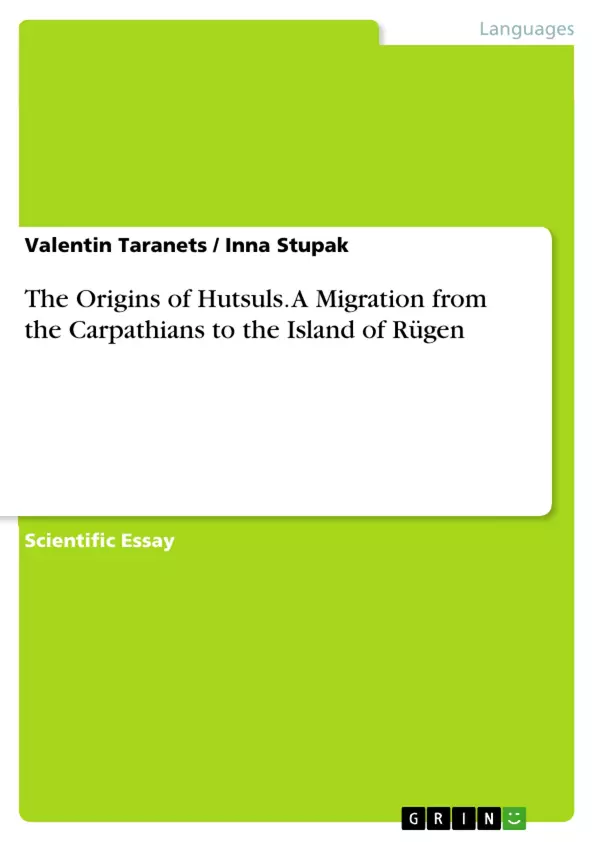The article presents the author’s considerations regarding the origin of Hutsuls, which is believed to stem from Galician tribes in the Carpathian region. After their migration to the island of Rügen, part of the Galicians returned to the Carpathians and went up to the mountains. They are traditionally referred to as Hutsuls-highlanders (shepherds) as opposed to Podolyan Galicians (Ruthenian).
The oldest studies on the origin of the word hutsuly include the article written by Polish researcher K. Milevskiy, who derived this ethnonym from the verb ʻroamʼ.
In this situation, in our opinion, a special approach is required, which would give us the opportunity to extract the semantic units from the existing form hutsuly, and allow us to view their origin from primary sources.
In our observations, we follow three positions on ethnonim hutsuly, to which R. F. Kayndl drew attention.
Based on the research done by V. T. Kolomiec and our observation, we conclude, that in ancient times the structure of words matched morphemic and phonetic (syllable) limit. In the relation to the reviewed ethnonym we can distinguish the syllables hu-tsul in which under the stress is prefix hu-.
Since in ide. linguistics it is believed that prefix forms of lexemes are secondary to the root forms, we can assume the existence of a derivation of meanings in the ethnonym hutsuly: ‘farmers’ → ‘mountainous (farmers, shepherds)’.
Previous remarks give us a reason to examine the origins of protoname of tribe of Hutsuls from the initial ide. root *ƙṷel-, which could be seen in the ancient ethnonym Halychany (without prefix hu-), related to the said root in the word hutsuly.
Inhaltsverzeichnis (Table of Contents)
- Introduction
- Formulation of the problem
- Structural analysis of the word Hutsul
- Ancient roots in the ethnonym
- The meaning of prefix hu-
- Semantics of the root -tsul
- Migrations of Hutsuls
- Analysis of Hutsul texts
- Related tribes on Rügen island
- The return of Hutsul to Carpathians
- Conclusions
Zielsetzung und Themenschwerpunkte (Objectives and Key Themes)
This article aims to explore the origins and migrations of the Hutsuls, a Ukrainian-speaking tribe residing in the Carpathian region. By analyzing the ethnonym "Hutsul" and related linguistic evidence, the authors seek to uncover the roots of the tribe's identity and their historical movements.
- The etymology of the ethnonym "Hutsul" and its significance in understanding the tribe's history
- The role of linguistic evidence in tracing the historical migrations of the Hutsuls
- The potential connections between the Hutsuls and other Slavic tribes, particularly the Galicians
- The cultural and linguistic impact of the Hutsuls' migration from the plains to the mountains
- The influence of historical events and environmental factors on the formation of Hutsul identity
Zusammenfassung der Kapitel (Chapter Summaries)
The introduction establishes the significance of the Hutsuls as an ancient Ukrainian-speaking tribe, highlighting the ambiguity surrounding the origins of their ethnonym. Chapter 1 delves into the historical study of the word "Hutsul," examining various interpretations by scholars, including those who linked it to roaming, Polish influence, or Romanian banditry. The authors emphasize the lack of consensus on the origin of the term due to limited written evidence. Chapter 2 provides a structural analysis of the word "Hutsul," focusing on its morphemic and phonetic structure. The authors propose that the ethnonym originates from the Indo-European root *el-, signifying "farmers," which aligns with the tribe's early agricultural practices. Chapter 3 explores the migrations of the Hutsuls, highlighting the importance of analyzing Hutsul texts and the narratives of elders in reconstructing their historical movements. This section delves into the potential connections between the Hutsuls and tribes on the island of Rügen, as well as the evidence of their return to the Carpathians.
Schlüsselwörter (Keywords)
The key terms and concepts explored in this article include: Slavic tribes, migration of Slavs, Galicians, Hutsuls, Ruthenian, ethnonym, linguistic analysis, Indo-European roots, Carpathian region, Hutsul texts, historical narratives, cultural identity.
- Arbeit zitieren
- Prof. Dr. Valentin Taranets (Autor:in), Inna Stupak (Autor:in), 2016, The Origins of Hutsuls. A Migration from the Carpathians to the Island of Rügen, München, GRIN Verlag, https://www.hausarbeiten.de/document/344681


